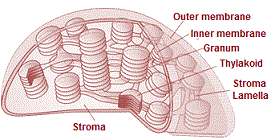The Plastids
Plastids are found in all plant cells and in euglenoides. Plastids are easily observed under the microscope as they are large. Plastids bear some specific pigments, thus imparting specific colours to the plants.
Plastids can be classified on the basis of type of pigments into chloroplasts, chromoplasts and leucoplasts.
The chloroplasts contain chlorophyll and carotenoid pigments which are responsible for trapping light energy essential for photosynthesis.
In the chromoplasts fat soluble carotenoid pigments like carotene, xanthophylls and others are present. This gives the part of the plant a yellow, orange or red colour.

The leucoplasts are the colourless plastids of varied shapes and sizes with stored nutrients:
Amyloplasts store carbohydrates (starch) - potato.
Elaioplasts store oils and fats
Aleuroplasts store proteins
Majority of the chloroplasts of the green plants are found in the mesophyll cells of the leaves. These are lens-shaped, oval, spherical, discoid or even ribbon-like organelles having variable length (5-10μm) and width (2-4μm). Their number varies from 1 per cell of the Chlamydomonas, a green alga to 20-40 per cell in the mesophyll.
Like mitochondria, the chloroplasts are also double membrane bound. Of the two, the inner chloroplast membrane is relatively less permeable. The space limited by the inner membrane of the chloroplast is called the stroma. A number of organised flattened membranous sacs called the thylakoids, are present in the stroma. Thylakoids are arranged in stacks like the piles of coins called grana (singular is granum) or the intergranal thylakoids.
In addition, there are flat membranous tubules called the stroma lamellae connecting the thylakoids of the different grana. The membrane of the thylakoids enclose a space called a lumen. The stroma of the chloroplast contains enzymes required for the synthesis of carbohydrates and proteins. It also contains small, doublestranded circular DNA molecules and ribosomes.
Chlorophyll pigments are present in the thylakoids. The ribosomes of the chloroplasts are smaller (70S) than the cytoplasmic ribosomes (80S).
Some important functions of plastids
Role in energy production
The outer mitochondrial membrane is freely permeable to small molecules and contains special channels capable of transporting large molecules. In contrast, the inner membrane is far less permeable, allowing only very small molecules to cross into the gel-like matrix that makes up the organelle’s central mass. The matrix contains the deoxyribonucleic acid (DNA) of the mitochondrial genome and the enzymes of the tricarboxylic acid (TCA) cycle which metabolizes nutrients into by-products the mitochondrion can use for energy production.
The processes that convert these by-products into energy occur primarily on the inner membrane, which is bent into folds known as cristae that house the protein components of the main energy-generating system of cells, the ETC.
The ETC uses a series of oxidation-reduction reactions to move electrons from one protein component to the next, ultimately producing free energy that is harnessed to drive the phosphorylation of ADP (adenosine diphosphate) to ATP.
This process is known as chemiosmotic coupling of oxidative phosphorylation, powers nearly all cellular activities, including those that generate muscle movement and fuel brain functions.